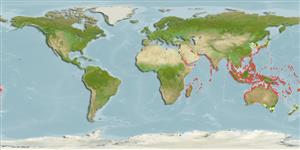Phaeophyceae |
Dictyotales |
Dictyotaceae
Environment: milieu / climate zone / depth range / distribution range
Ecology
Sessile. Tropical
Indo-Pacific: from Seychelles and Thailand to Japan, Indonesia, Micronesia and Fiji.
Length at first maturity / Size / Weight / Age
Maturity: Lm ? range ? - ? cm
Thalli fan-shaped, yellowish brown to light brown or slightly whitish due to light calcification. Blade entire or divided into lobes, consisting of 2 layers of cells. Lower surface of blade divided into concentric zones by hairlines which are equidistant from each other; non-indusiate reproductive sori also form concentric lines directly above each hairline. Blade up to 10 cm in height (Ref. 80758).
A source of algin (Ref. 80758); very abundant during the sunny months of the year (Ref. 80758). Attached to solid substrates on reef flats or in the upper subtidal zone, or epiphytic on large macrobenthic algae and seagrass. Grows on inner reef flats and on tidal pools on the outer portions of reef flats (Ref. 80758)
Life cycle and mating behavior
Maturity | Reproduction | Spawning | Eggs | Fecundity | Larvae
Guiry, M.D. and G.M. Guiry 2009 AlgaeBase. World-wide electronic publication, National University of Ireland, Galway. http://www.algaebase.org; searched on 14 April 2009. (Ref. 80701)
IUCN Red List Status
(Ref. 130435: Version 2025-1)
CITES status (Ref. 108899)
Not Evaluated
Not Evaluated
Threat to humans
Human uses
| FishSource |
Tools
More information
Trophic EcologyFood items (preys)
Diet composition
Food consumption
Predators
Population dynamicsGrowth
Max. ages / sizes
Length-weight rel.
Length-length rel.
Length-frequencies
Mass conversion
Abundance
Life cycleReproduction
Maturity
Fecundity
Spawning
Eggs
Egg development
Larvae
PhysiologyOxygen consumption
Human RelatedStamps, coins, misc.
Internet sources
Estimates based on models
